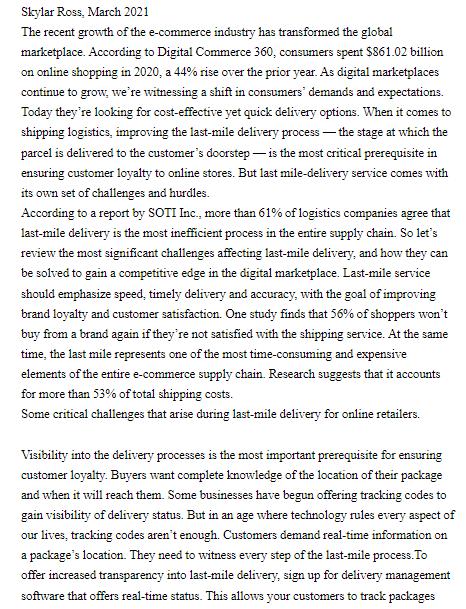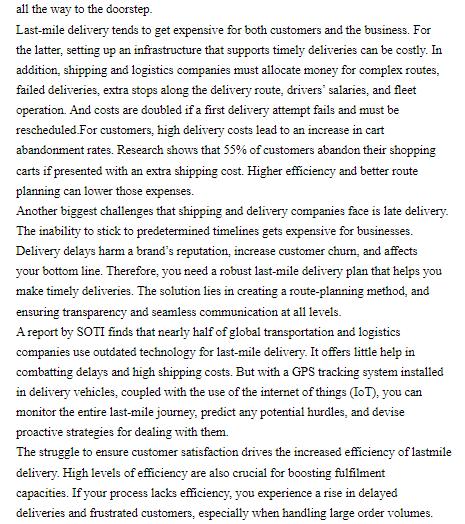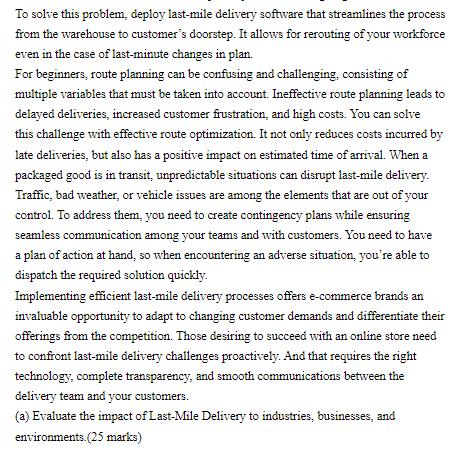Answered step by step
Verified Expert Solution
Question
1 Approved Answer
Skylar Ross, March 2021 The recent growth of the e-commerce industry has transformed the global marketplace. According to Digital Commerce 360, consumers spent $861.02



Skylar Ross, March 2021 The recent growth of the e-commerce industry has transformed the global marketplace. According to Digital Commerce 360, consumers spent $861.02 billion on online shopping in 2020, a 44% rise over the prior year. As digital marketplaces continue to grow, we're witnessing a shift in consumers' demands and expectations. Today they're looking for cost-effective yet quick delivery options. When it comes to shipping logistics, improving the last-mile delivery process the stage at which the parcel is delivered to the customer's doorstep is the most critical prerequisite in ensuring customer loyalty to online stores. But last mile-delivery service comes with its own set of challenges and hurdles. According to a report by SOTI Inc., more than 61% of logistics companies agree that last-mile delivery is the most inefficient process in the entire supply chain. So let's review the most significant challenges affecting last-mile delivery, and how they can be solved to gain a competitive edge in the digital marketplace. Last-mile service should emphasize speed, timely delivery and accuracy, with the goal of improving brand loyalty and customer satisfaction. One study finds that 56% of shoppers won't buy from a brand again if they're not satisfied with the shipping service. At the same time, the last mile represents one of the most time-consuming and expensive elements of the entire e-commerce supply chain. Research suggests that it accounts for more than 53% of total shipping costs. Some critical challenges that arise during last-mile delivery for online retailers. Visibility into the delivery processes is the most important prerequisite for ensuring customer loyalty. Buyers want complete knowledge of the location of their package and when it will reach them. Some businesses have begun offering tracking codes to gain visibility of delivery status. But in an age where technology rules every aspect of our lives, tracking codes aren't enough. Customers demand real-time information on a package's location. They need to witness every step of the last-mile process. To offer increased transparency into last-mile delivery, sign up for delivery management software that offers real-time status. This allows your customers to track packages all the way to the doorstep. Last-mile delivery tends to get expensive for both customers and the business. For the latter, setting up an infrastructure that supports timely deliveries can be costly. In addition, shipping and logistics companies must allocate money for complex routes, failed deliveries, extra stops along the delivery route, drivers' salaries, and fleet operation. And costs are doubled if a first delivery attempt fails and must be rescheduled For customers, high delivery costs lead to an increase in cart abandonment rates. Research shows that 55% of customers abandon their shopping carts if presented with an extra shipping cost. Higher efficiency and better route planning can lower those expenses. Another biggest challenges that shipping and delivery companies face is late delivery. The inability to stick to predetermined timelines gets expensive for businesses. Delivery delays harm a brand's reputation, increase customer churn, and affects your bottom line. Therefore, you need a robust last-mile delivery plan that helps you make timely deliveries. The solution lies in creating a route-planning method, and ensuring transparency and seamless communication at all levels. A report by SOTI finds that nearly half of global transportation and logistics companies use outdated technology for last-mile delivery. It offers little help in combatting delays and high shipping costs. But with a GPS tracking system installed in delivery vehicles, coupled with the use of the internet of things (IoT), you can monitor the entire last-mile journey, predict any potential hurdles, and devise proactive strategies for dealing with them. The struggle to ensure customer satisfaction drives the increased efficiency of lastmile delivery. High levels of efficiency are also crucial for boosting fulfilment capacities. If your process lacks efficiency, you experience a rise in delayed deliveries and frustrated customers, especially when handling large order volumes. To solve this problem, deploy last-mile delivery software that streamlines the process from the warehouse to customer's doorstep. It allows for rerouting of your workforce even in the case of last-minute changes in plan. For beginners, route planning can be confusing and challenging, consisting of multiple variables that must be taken into account. Ineffective route planning leads to delayed deliveries, increased customer frustration, and high costs. You can solve this challenge with effective route optimization. It not only reduces costs incurred by late deliveries, but also has a positive impact on estimated time of arrival. When a packaged good is in transit, unpredictable situations can disrupt last-mile delivery. Traffic, bad weather, or vehicle issues are among the elements that are out of your control. To address them, you need to create contingency plans while ensuring seamless communication among your teams and with customers. You need to have a plan of action at hand, so when encountering an adverse situation, you're able to dispatch the required solution quickly. Implementing efficient last-mile delivery processes offers e-commerce brands an invaluable opportunity to adapt to changing customer demands and differentiate their offerings from the competition. Those desiring to succeed with an online store need to confront last-mile delivery challenges proactively. And that requires the right technology, complete transparency, and smooth communications between the delivery team and your customers. (a) Evaluate the impact of Last-Mile Delivery to industries, businesses, and environments. (25 marks)
Step by Step Solution
There are 3 Steps involved in it
Step: 1
the whereabouts of their packages This requires the implementation of advanced tracking systems and ...
Get Instant Access to Expert-Tailored Solutions
See step-by-step solutions with expert insights and AI powered tools for academic success
Step: 2

Step: 3

Ace Your Homework with AI
Get the answers you need in no time with our AI-driven, step-by-step assistance
Get Started


